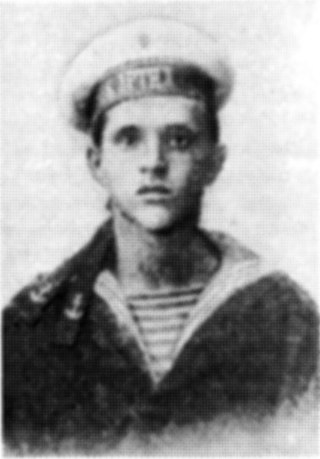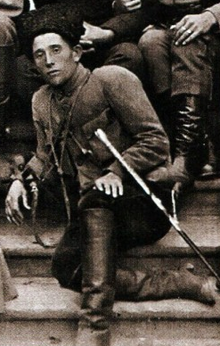
Nestor Ivanovych Makhno, also known as Bat'ko Makhno, was a Ukrainian anarchist revolutionary and the commander of the Revolutionary Insurgent Army of Ukraine during the Ukrainian War of Independence. He established the Makhnovshchina, a mass movement by the Ukrainian peasantry to establish anarchist communism in the country between 1918 and 1921. Initially centered around Makhno's home province of Katerynoslav and hometown of Huliaipole, it came to exert a strong influence over large areas of southern Ukraine, specifically in what is now the Zaporizhzhia Oblast of Ukraine.

Dmitry Ivanovich Popov was a Russian sailor and Left Socialist-Revolutionary that led the Left SR uprising against the Bolsheviks in July 1918. Following the suppression of the uprising, he joined the Revolutionary Insurgent Army of Ukraine and became a leading member, spearheading the negotiations between the Makhnovists and the Bolsheviks until his arrest and execution by the Cheka.
The Makhnovshchina was a mass movement to establish anarchist communism in southern and eastern Ukraine during the Ukrainian War of Independence of 1917–1921. Named after Nestor Makhno, the commander-in-chief of the Revolutionary Insurgent Army of Ukraine, its aim was to create a system of free soviets that would manage the transition towards a stateless and classless society.

Fedir Shchus was a Ukrainian military commander (ataman) in the Revolutionary Insurgent Army of Ukraine during the Russian Civil War.

Viktor Fedorovych Bilash was a Ukrainian military commander who was the Chief of Staff of the Revolutionary Insurgent Army of Ukraine (RIAU) under Nestor Makhno during the Russian Civil War. A gifted military commander, Bilash himself planned many of the Insurgent Army's operations, later becoming its commander in chief after Makhno's flight into exile.

Semen Mykytovych Karetnyk was a Ukrainian anarchist revolutionary and military commander in the Revolutionary Insurgent Army of Ukraine (RIAU). He often replaced Nestor Makhno as supreme commander of the Insurgent Army in 1920. Karetnyk gained a reputation for his central role in defeating the White Army in Crimea in November 1920.

Lev Mykolaiovych Zadov, also known by his nom de guerreLev Zinkovskyi, was chief of military intelligence of the Revolutionary Insurgent Army of Ukraine (RIAU) and later an operative of the Joint State Political Directorate (OGPU).

The Revolutionary Insurgent Army of Ukraine, also known as Makhnovtsi, named after their leader Nestor Makhno, was an anarchist army formed largely of Ukrainian peasants and workers during the Russian Civil War. They protected the operation of "free soviets" and libertarian communes by the Makhnovshchina, an attempt to form a stateless anarcho-communist society from 1918 to 1921 during the Ukrainian War of Independence.
Petro Havrylenko was a Ukrainian anarchist that acted as a commander and chief of staff in the Revolutionary Insurgent Army of Ukraine during the Ukrainian Civil War.
Oleksiy Vasylovych Chubenko was a diplomat for the Revolutionary Insurgent Army of Ukraine.

The Military Revolutionary Council was the de facto executive of the Makhnovshchina, empowered to act during the interim between sittings of the Regional Congresses.

Oleksiy Ivanovych Marchenko was a Ukrainian anarchist military leader, who fought in the war of independence as a cavalry commander in the Revolutionary Insurgent Army of Ukraine.
The Polonsky conspiracy, also known as the Polonsky plot or Polonsky affair, was an attempt by Ukrainian Bolsheviks to overthrow the Makhnovshchina during the autumn of 1919.
Yevgeny Polonsky, also known as M. L. Polonsky, was a Ukrainian soldier in the Red Army and the leader of a Bolshevik conspiracy to overthrow the Makhnovshchina.

Foma Kozhyn was a Ukrainian revolutionary and the commander of the machine-gun regiment of the Revolutionary Insurgent Army of Ukraine.
The Road to Freedom was the main newspaper of the Makhnovist movement, publishing 50 issues from May 1919 to November 1920.

The Starobilsk agreement was a 1920 political and military alliance between the Makhnovshchina, an anarchist mass movement led by Nestor Makhno's Insurgent Army, and the Ukrainian Soviet Socialist Republic, which the Bolsheviks had established as the legitimate government of Ukraine.
The Kontrrazvedka was the counterintelligence division of the Revolutionary Insurgent Army of Ukraine. Its main functions were to carry out military reconnaissance, the prosecution of captured enemies and counter-insurgency operations.
The Bolshevik–Makhnovist conflict was a period of political and military conflict between the Ukrainian Soviet Socialist Republic and the Makhnovshchina, for control over southern Ukraine. The Bolsheviks aimed to eliminate the Makhnovshchina and neutralise its peasant base. In turn, the Makhnovists fought against the implementation of the Red Terror and the policy of war communism.
Yakiv Sukhovolski, also known by his nom de guerreYakiv Alyi (1880–1920) was a Ukrainian anarcho-syndicalist and writer. He was a member of the secretariat of the Nabat.











